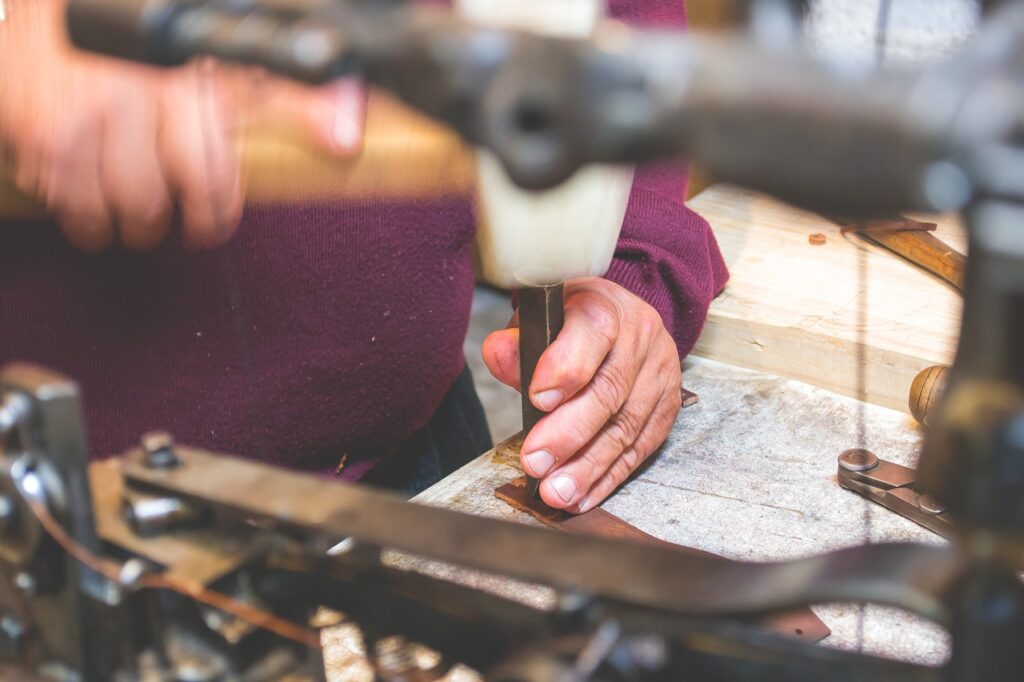To Share is to Show You Care!
Are you tired of embarking on DIY projects only to end up with a chaotic mess and heaps of wasted materials? In 2023, it’s time to turn your DIY endeavors into works of art while saving time and resources. In this blog post, we’ll share the best DIY hack to transform chaos into craftsmanship.
1. Introduction
DIY projects are a fantastic way to express your creativity and save money, but they often lead to clutter, frustration, and wastage. Let’s explore the best DIY hack that will help you achieve your goals efficiently and minimize unnecessary waste.
2. Why Chaos and Waste Happen
Before we delve into the solution, it’s important to understand why chaos and waste occur in DIY projects. Typically, it’s due to lack of planning, disorganization, and not using materials effectively. Here are the common culprits:

2.1 Lack of Planning
Not having a clear plan in place can lead to confusion and mistakes. Planning includes defining the project’s scope, setting goals, and creating a step-by-step plan.
2.2 Disorganization
Cluttered workspaces and scattered tools make it difficult to focus on your project. Disorganization can also lead to lost or damaged tools and materials.
2.3 Inefficient Material Use
Cutting, measuring, or applying materials incorrectly can result in waste. This could be using more material than necessary, making incorrect cuts, or not following manufacturer guidelines.
3. The Best DIY Hack for 2023
To transform chaos into craftsmanship and reduce waste, follow these essential steps,

3.1 Plan and Prepare
3.1.1 Create a detailed project plan
Start by defining the scope of your project, listing the steps needed to complete it, and estimating the materials and tools required.
3.1.2 Gather all necessary materials and tools
Before you start your DIY project, ensure you have everything you need. This prevents interruptions and keeps you focused on the task at hand.
3.2 Organize Your Workspace
3.2.1 Clear your workspace of unnecessary clutter
Remove any items that are not related to your project. An organized workspace will help you work more efficiently and avoid distractions.
3.2.2 Arrange tools and materials in an orderly fashion
Have a designated place for each tool and material. This ensures you can easily find what you need when you need it.
3.3 Measure Twice, Cut Once
3.3.1 Double-check your measurements before cutting materials
Measure precisely to avoid errors. Double-checking ensures that you’re cutting materials to the correct dimensions.
3.3.2 Use precision tools
High-quality, precise tools will help you make accurate cuts, leading to better results and less waste.
3.4 Use Materials Efficiently
3.4.1 Explore ways to minimize waste
Think about how you can reduce material waste, such as reusing or repurposing materials from previous projects. Be creative in finding alternative uses for materials.
3.4.2 Follow manufacturer recommendations for material usage
Read and follow the instructions provided by material manufacturers to ensure you’re using them efficiently and effectively.
3.5 Proper Disposal
3.5.1 Dispose of waste materials responsibly
If you do generate waste, make sure to dispose of it in an environmentally friendly way, following your local disposal guidelines. Recycling materials when possible is a good practice.
3.5.2 Consider donating unused materials:
Instead of throwing away unused materials, consider donating them to local charities or other DIY enthusiasts who may have a use for them.
4. Best DIY Books available online
This blog post offers a valuable service by summarizing the pros and cons based on hundreds of Amazon product reviews. By doing so, it helps potential buyers save time and make informed decisions when considering the product.
4.1 Safe and Sound: A Renter-Friendly Guide to Home Repair Hardcover
| Kindle | Hardcover | Spiral-bound |
 |  |  |
Practical and Empowering: The book is highly praised for its practical guidance, making it easy for readers to tackle home repairs confidently. It empowers renters and homeowners to take control of their living spaces and feel more self-sufficient.
Renter-Friendly Focus: Readers appreciate the book’s focus on renter-specific challenges and limitations, which makes it particularly useful for those living in spaces they don’t own. The book offers valuable insights for communicating with landlords and understanding tenant rights.
Clear and Approachable Writing: The author’s approachable and encouraging writing style is highlighted as a major advantage. Readers find the instructions and guidance easy to follow, even for those with minimal experience in DIY and home maintenance.
Cons:
No Cons Mentioned: None of the provided reviews mention any specific cons or drawbacks of the book. The book appears to be well-received by readers, and no negative aspects are pointed out in the reviews.
Editor’s Comments
It’s important to note that these pros and cons are based on the information provided in the reviews, and individual experiences with the book may vary.
4.2 Ultimate Guide to Home Repair and Improvement, 3rd Updated Edition: Proven Money-Saving Projects, 3,400 Photos & Illustrations (Creative Homeowner) 608-Page Resource with 325 Step-by-Step DIY Projects
| Hardcover |
 |
Comprehensive Content: Many reviewers appreciate the book’s comprehensive coverage of various home repair and improvement topics. They find it to be a valuable resource for a wide range of subjects related to DIY home projects.
Detailed Instructions: Several readers commend the book for its detailed step-by-step instructions, making it easy for both beginners and experienced DIY enthusiasts to follow along. The inclusion of 3,400 photos and illustrations is particularly helpful.
Great for Beginners: Reviewers note that the book is suitable for those with limited experience in home repair. It provides clear explanations and visuals that are easy to understand, making it an excellent choice for beginners.
Useful Gift: Many customers mention giving the book as a gift, and it has received positive feedback from recipients. It’s seen as a thoughtful and practical gift, especially for new homeowners or DIY enthusiasts.
Covers a Wide Range of Topics: Readers find the book useful because it goes beyond basic home repairs and includes information on more complex renovations, safety, planning, and preparation. It also covers subjects that are often overlooked in other DIY resources.
Cons:
Limited Elaboration: Some reviewers believe that while the book covers many subjects, it could provide more in-depth information on certain topics. However, they acknowledge that providing more detail might make the book too large and challenging to handle.
Heavy Book: A few customers point out that the book is heavy, which may make it less convenient to carry around or use in certain situations.
Binding Issues: Two customers reported issues with the binding of the hardcover edition. They received books with binding problems, with one book completely separating from the binding and the other about to do so. This suggests potential quality control issues with the physical copies of the book.
Editor’s Comments
It’s important to consider these pros and cons when evaluating the book, as they reflect the experiences and opinions of readers. The book appears to be a valuable resource for home repair and improvement, especially for those looking for a comprehensive guide, but potential binding issues should be considered when purchasing a physical copy.
4.3 Ultimate Guide: Wiring, 9th Updated Edition (Creative Homeowner) DIY Residential Home Electrical Installations and Repairs – Switches, Outdoor Lighting, LED, and More, with Step-by-Step Photos
| Kindle Version | Paper back | Spiral-bound |
 |  |  |
Informative Content: Many customers find the book to be informative and a valuable resource for understanding electrical wiring. It provides clear explanations and instructions.
Great Illustrations: Reviewers appreciate the book’s visual aids and illustrations, which help make complex topics easier to understand. The pictures and diagrams are seen as a strong point of the book.
Detailed Descriptions: The book is described as detailed, and it’s considered a good reference for both beginners and experienced individuals working on electrical projects.
Covers Various Topics: Customers note that the book covers various aspects of electrical work, which is useful for a range of DIY electrical projects.
Helpful for Novices: The book is particularly suitable for novices, providing them with essential knowledge and guidance for home electrical projects.
Updated Information: Some customers mention that the book includes up-to-date information on electrical codes and wiring techniques, making it a reliable reference for current practices.
Cons:
Misleading Title: One review mentions that the title of the book is misleading as the book is about electrical wiring, but it’s not related to plumbing, as suggested by the first review.
Basic Information: A few reviewers note that the book may contain basic information, which might not be suitable for experienced electricians. It may lack in-depth details for certain advanced electrical work.
Older Information: There is one complaint about the book not covering newer smart home technology (Zigbee, Wi-Fi, IOT) in detail. The customer expected the book to be more updated in this aspect.
Physical Book Condition: In one review, the customer received a physical book that appeared to be used or damaged, despite ordering a new copy. This suggests potential issues with the book’s physical quality.
Editor’s Comments
Overall, the book appears to be well-received for its informative content and clear explanations, especially for those looking to learn about electrical wiring for home projects. However, there are a few concerns, such as the book’s basic nature and limited coverage of newer technologies. Additionally, the quality of the physical copy may vary.
4.4 Ultimate Guide: Plumbing, Updated 5th Edition (Creative Homeowner) Beginner-Friendly Step-by-Step Projects, Comprehensive How-To Information, Code-Compliant Techniques for DIY, and Over 800 Photos
| KINDLE | PAPERBACK | SPIRAL-BOUND |
 |  |  |
Comprehensive and Detailed Content: Customers appreciate that the book provides comprehensive coverage of plumbing. It contains 305 pages of clearly written, comprehensive information with large colorful pictures and detailed illustrations. This makes it an excellent resource for plumbing knowledge.
Useful for DIY: Reviewers mention that the book is beginner-friendly and includes step-by-step projects. This makes it suitable for those who want to tackle plumbing projects on their own.
High-Quality Images: The large, colorful pictures and detailed illustrations are a significant advantage, as they help readers understand the concepts more easily.
Informative and Educational: Customers have found the book to be highly informative and educational, teaching both the basics of plumbing and more advanced subjects for repairs and installations.
Value for Money: Many reviewers consider it a valuable purchase for the amount of knowledge it provides at a reasonable price.
Cons:
Limited Updates: Some reviewers note that the book’s information is not the most up-to-date. They mention that it’s not a new book, and some of the information and images are dated. For example, the book does not cover the latest methods and technology in plumbing, which may be a drawback for those looking for the most current information.
Not Detailed Enough for Some: A few customers find the book lacking in detail, especially for major plumbing jobs. It is seen as more suitable for smaller DIY projects rather than complex plumbing work.
Missing Information: There are complaints that the book doesn’t cover every aspect of plumbing, such as specific tasks like cutting sink pipes, measuring correctly, fixing leaking pipes, or dealing with different tailpiece sizes.
Limited Focus: The book is primarily oriented toward the North American plumbing context, which may not be as relevant to readers in other regions, such as Australia, where plumbing practices and materials may differ.
No Information on Hot Water Heating: One customer mentions that the book lacks information on hot water heating, which might be relevant for certain readers.
Editor’s Comments
In summary, the “Ultimate Guide: Plumbing, Updated 5th Edition” is appreciated for its comprehensive and informative content, making it suitable for DIY plumbing projects. However, it may not provide the most up-to-date information, and it may not cover every plumbing scenario or specific details, which could be a limitation for those with more advanced needs or different regional requirements.
4.5 Beginner’s Guide to DIY & Home Repair: Essential DIY Techniques for the First Timer (Creative Homeowner) Practical Handbook for Complete Beginners with Expert Advice & Easy Instructions for Novices
| KINDLE | PAPERBACK |
 |  |
Beginner-Friendly: Many customers find the book helpful for beginners, especially those who have little or no experience with DIY home repairs. It is designed to guide novices through various DIY tasks.
Clear and Easy to Follow: Reviewers appreciate that the book is well laid out, easy to follow, and provides step-by-step instructions. It’s presented in a way that’s accessible to individuals who may not be familiar with DIY projects.
Useful for Learning Basic Skills: Customers mention that the book is excellent for teaching basic skills. It provides explanations and visuals that are particularly valuable for those who are starting from scratch.
Overcoming Fear: The book is noted for helping individuals overcome their fear of using tools and handling basic repair tasks. It offers guidance that makes DIY projects seem less intimidating.
Great Gift for Novices: Some customers mention that this book makes for a great gift, especially for young homeowners who are new to DIY and home repairs.
Cons:
Too Basic for Some: A few reviewers feel that the book is overly basic and lacks detailed information. They believe it doesn’t cover more advanced DIY tasks and may not provide enough depth for those with some prior experience.
Limited Scope: While it’s helpful for beginners, some customers think the book has a limited scope, focusing mainly on the very basics. It may not cover a wide range of DIY projects.
Misleading Expectations: There is feedback from customers who feel that the book’s title and description are somewhat misleading. They expected a more comprehensive manual but found it to be more geared toward essential DIY techniques for absolute beginners.
Price Concerns: A few customers express dissatisfaction with the book’s price, feeling it doesn’t offer enough content or depth to justify the cost.
May Not Cover Advanced Projects: Those seeking information on advanced or complex DIY projects may find this book lacking. It’s primarily for individuals looking to start with very basic home repairs.
Editor’s Comments
In summary, the “Beginner’s Guide to DIY & Home Repair” is generally praised for its accessibility and suitability for true beginners. It provides clear instructions for basic DIY tasks and helps people overcome their initial fears. However, some users feel it lacks depth and may not be suitable for individuals with some prior DIY experience or those looking for comprehensive guidance on advanced projects. Additionally, the pricing and expectations regarding the book’s content have led to mixed reviews.
5. Benefits of Implementing this DIY Hack
By following these steps, you’ll experience the following benefits,

5.1 Reduced Waste
Minimizing waste helps the environment and saves you money. You’ll be throwing away less and spending less on materials.
5.2 Increased Efficiency
Your projects will progress smoothly and efficiently, saving you time and reducing frustration.
5.3 Improved Quality
Better planning and organization lead to higher-quality results, making your DIY projects more satisfying and professional.
5.4 Enhanced Creativity
With chaos out of the way, you’ll have more mental space for creativity. You can focus on the artistic aspects of your project without being bogged down by disorganization and waste.
Conclusion
In 2023, take your DIY projects to the next level by adopting the best DIY hack to transform chaos into craftsmanship. Say goodbye to wasted time, materials, and unnecessary mess. Embrace a more organized, efficient, and eco-friendly approach to your DIY endeavors, and watch your projects flourish.
By implementing these tips, you can turn your DIY projects into works of art while being kind to both your wallet and the environment. Don’t let chaos and waste hinder your creativity – start your journey towards craftsmanship today!
Frequently Asked Questions
Q1: How can you avoid creating more waste?
A: To avoid creating more waste, you can:
- Reduce: Use fewer disposable products and choose items with less packaging.
- Reuse: Find creative ways to repurpose items instead of throwing them away.
- Recycle: Properly recycle materials like paper, plastic, and glass.
- Compost: Turn organic waste into nutrient-rich compost for your garden.
- Choose durable products: Invest in high-quality, long-lasting items.
- Shop with sustainability in mind: Support companies that prioritize eco-friendly practices.
- Buy in bulk: Purchase items with less packaging or in larger quantities.
- Use cloth bags: Bring your own reusable bags when shopping.
- Minimize food waste: Plan meals, store food properly, and use leftovers.
- Repair instead of replace: Fix broken items when possible.
Q2: What are 10 ways to reduce waste?
A: Ten ways to reduce waste include:
- Use reusable shopping bags and containers.
- Buy products in bulk to reduce packaging waste.
- Reduce food waste by meal planning and proper storage.
- Recycle paper, plastic, glass, and aluminum.
- Compost organic waste to create nutrient-rich soil.
- Choose products with minimal or recyclable packaging.
- Repair or repurpose items instead of throwing them away.
- Opt for digital documents instead of printing.
- Use a reusable water bottle and coffee cup.
- Support eco-friendly products and companies.
Q3: How can we reduce waste at home?
A: To reduce waste at home, you can:
Practice the 5 R’s: Refuse, Reduce, Reuse, Recycle, and Rot (compost).
- Minimize single-use items like paper towels and disposable utensils.
- Recycle paper, cardboard, glass, plastic, and aluminum.
- Compost food scraps and yard waste.
- Use cloth napkins instead of disposable ones.
- Repurpose items for new uses.
- Donate or sell unwanted items.
- Buy in bulk to reduce packaging waste.
- Choose durable and long-lasting products.
- Conserve energy and water to reduce utility waste.
Q4: How do you make eco-friendly crafts?
A: To make eco-friendly crafts:
- Use recycled or repurposed materials.
- Choose non-toxic and low-impact art supplies.
- Minimize waste by planning your project carefully.
- Repurpose items from your home or local thrift stores.
- Create crafts that have a practical use, reducing decorative clutter.
- Teach others about the importance of eco-friendly crafting.
Q5: What are 5 examples of reduce?
A: Five examples of reduce include:
- Reducing water usage by fixing leaks and taking shorter showers.
- Reducing energy consumption by turning off lights and appliances when not in use.
- Reducing waste by using cloth diapers instead of disposable ones.
- Reducing plastic pollution by using a refillable water bottle.
- Reducing paper waste by switching to digital documents and emails.
Q6: What are 10 ways to reuse?
A: Ten ways to reuse include:
- Use glass jars for storage or as containers.
- Turn old clothing into rags or quilts.
- Repurpose wooden pallets into furniture or garden structures.
- Refill empty containers with bulk products.
- Use old newspapers for packing material or crafts.
- Convert an old ladder into a bookshelf.
- Turn wine corks into a bulletin board.
- Create art from scrap materials.
- Use broken or mismatched dishes for mosaic projects.
- Repurpose old windows as decorative frames.
Q7: What is zero waste project?
A: A zero waste project aims to minimize the generation of waste and reduce environmental impact. It involves adopting practices such as reducing, reusing, recycling, composting, and choosing products with minimal packaging. The goal is to send as little waste as possible to landfills or incineration, moving towards a circular economy where resources are conserved and reused efficiently.
Q8: What are the 5 R’s of waste reduction?
A: The 5 R’s of waste reduction are:
- Refuse: Say no to items or practices that generate unnecessary waste.
- Reduce: Minimize the amount of waste you create by using fewer resources.
- Reuse: Find new uses for items to extend their lifespan.
- Recycle: Process materials so they can be used to create new products.
- Rot: Compost organic waste to create nutrient-rich soil.
Q9: What are the 7 R’s of waste reduction?
A: The 7 R’s of waste reduction expand on the 5 R’s and include:
- Refuse: Avoid acquiring unnecessary items or generating waste.
- Reduce: Use fewer resources and produce less waste.
- Reuse: Find creative ways to use items again.
- Repair: Fix broken items instead of replacing them.
- Repurpose: Give items a new purpose or function.
- Recycle: Process materials for reuse in new products.
- Rot: Compost organic waste, turning it into nutrient-rich soil.
Q10: How do I start zero waste?
A: To start a zero waste lifestyle, follow these steps:
- Assess your current waste habits.
- Set achievable goals for reducing waste.
- Refuse single-use items and unnecessary packaging.
- Reduce consumption by buying consciously.
- Reuse items creatively instead of discarding them.
- Recycle and compost properly.
- Compost organic waste.
- Engage with a zero waste community for support and ideas.
- Continue to educate yourself about sustainability.
Q11: What should we reduce?
A: We should reduce:
- Single-use plastics and disposable items.
- Excessive energy and water consumption.
- Food waste through better meal planning.
- Excessive consumption of goods and fast fashion.
- Toxic and non-recyclable materials in products.
- Wasteful practices in manufacturing and packaging.
- Carbon emissions and pollution through eco-friendly choices.
Q12: What kinds of items might be reused?
A: Various items can be reused, including:
- Clothing and textiles
- Furniture
- Glass containers
- Wooden pallets
- Plastic containers
- Old electronics and appliances
- Books and magazines
- Jars and bottles
- Tires
- Paper and cardboard
Q13: How can I be 100% eco-friendly?
A: Becoming 100% eco-friendly is challenging but possible. To achieve this, focus on:
- Reducing waste to a minimum.
- Using clean energy sources.
- Conserving water and reducing water waste.
- Eating a plant-based diet or supporting sustainable agriculture.
- Choosing sustainable transportation options.
- Supporting eco-friendly products and companies.
- Practicing ethical and sustainable living in all aspects of life.
Q14: What is eco-friendly home decor?
A: Eco-friendly home decor involves decorating your living space with items and materials that have minimal impact on the environment. It includes using sustainable materials, recycling or upc
The Informed Minds
I'm Vijay Kumar, a consultant with 20+ years of experience specializing in Home, Lifestyle, and Technology. From DIY and Home Improvement to Interior Design and Personal Finance, I've worked with diverse clients, offering tailored solutions to their needs. Through this blog, I share my expertise, providing valuable insights and practical advice for free. Together, let's make our homes better and embrace the latest in lifestyle and technology for a brighter future.

